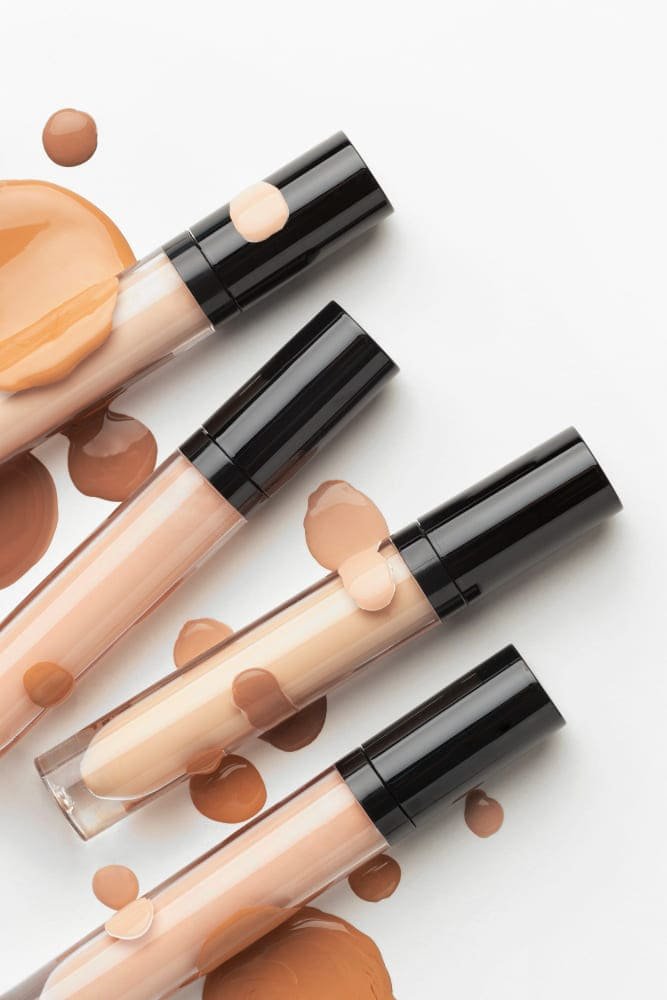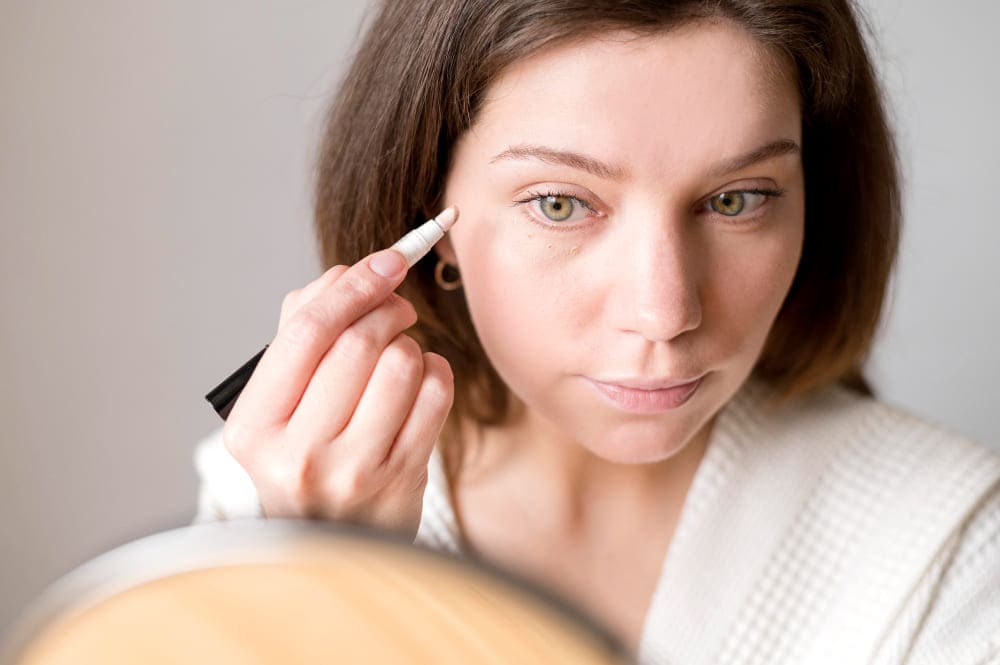Inside Article
Choose a Concealer Shade for Your Skin tone
Concealer is a beauty staple, a magical solution for those looking to minimize the appearance of dark circles, blemishes, and other skin imperfections. However, with such a wide range of concealor shades and types available, it can be overwhelming to choose the one that perfectly fits your unique skin tone. Whether you’re a beauty enthusiast seeking to fine-tune your makeup technique, a skincare aficionado on the hunt for the latest tips, or a makeup beginner eager to master the basics, this guide is tailored to help everyone find their perfect concealer shade match.
Selecting the Right Concealer Shade

Consider Your Skin Type
Another crucial factor in selecting a concealer is considering your skin type. If you have dry skin, opt for a hydrating and creamy formula to avoid emphasizing dry patches. For oily skin, look for concealers with matte and oil-free finishes to prevent sliding or creasing. If you have combination skin, choose a concealer that works for both your dry and oily areas.
Identifying Your Skin Tone
Skin tone refers to the surface color that lies on top of your underlying undertone. It is generally categorized into light, medium, and dark. To find out where you fall on the scale, stand in natural light and look at your face’s overall appearance. If you notice a yellow or peachy tinge, you’re likely to have a light skin tone; if you have an olive or golden hue, your skin tone is medium; and if you have a deep brown or ebony complexion, your skin tone is dark.
Understanding Skin Undertones
Skin undertones are key to selecting a concealer that appears natural rather than distinctly separate from your foundational skin color. Warm undertones often have a golden or peach cast, cool undertones display hints of pink or blue, while neutral undertones are a balance between the two. Recognizing your undertone will guide you not only in concealer selection but for all makeup products. A simple test to determine your undertone is to check the veins in your wrist – if they appear green, you have warm undertones; if they look blue or purple, you have cool undertones; and if they seem a mix of both, you have neutral undertones.
Testing the Concealor Shade
When trying out concealers, it’s essential to test the shade before purchasing. The best way to do this is by swatching the concealer on your jawline or neck in natural light. This will give you a better idea of how the concealer will look against your skin tone and blend with your foundation
Choosing the Right Concealor Shade

Don’t be Afraid to Mix
If you can’t find the perfect concealor shade for your skin tone, don’t be afraid to mix two shades together. This is especially useful if you have a unique undertone or a hard-to-match complexion. Mixing concealers also allows for more versatility and the ability to customize your coverage depending on your needs.
General Tips and Tricks
- When in doubt, go for a slightly lighter shade rather than a darker one.
- Don’t forget to blend your concealer well, especially around the edges, for a seamless finish.
- Use color correctors under your concealer if you have stubborn dark circles or discoloration.
- If you have mature skin, opt for lightweight and hydrating concealers to avoid emphasizing fine lines or wrinkles.
- For best results, use a brush or beauty blender to apply your concealer.
- Set your concealer with a translucent powder to ensure it stays in place all day.
Matching Your Foundation
Ideally, your concealer should either match or be slightly lighter than your foundation. Testing colors side-by-side in natural light is the most dependable method. While some prefer trying shades on the back of their hand, it’s best to test directly on the face, as the skin tone can vary.
Mastering Natural Lighting for Flawess Concealer Application
Natural lighting provides the truest representation of your skin. When testing concealers, do so in a well-lit area, preferably near a window, to ensure the color you choose blends seamlessly with your complexion.
Using the Color Wheel for Your Ideal Concealer Shade

Color Correction Techniques
A crucial point mentioned in provided documents is color correction, especially for the under-eye area. A concealer with peach or orange undertones can neutralize dark circles. Conversely, for covering red blemishes, a touch of green mixed into your concealer can make all the difference.
Area-Specific Concealers Shades
Different areas of the face may require different concealers. For instance, a thicker, more pigmented concealer might work best for covering a blemish, while a lighter, illuminating formula is often preferred for brightening the delicate under-eye area.
Types of Concealer
Each concealer has a format with a specific benefit:
Liquid Concealers: Versatile and suitable for most skin types, particularly oily skin. They provide various levels of coverage, from light to full, and are less likely to cake, making them excellent for mature or dry skin areas.
Stick Concealers: These offer thicker coverage and work well for disguising blemishes and spots, but may require careful blending to avoid a heavy look.
Cream Concealers: Typically packaged in a pot or palette, cream concealers are more concentrated and provide significant coverage for blemishes and discoloration. They also work well for dry skin, as they are usually more moisturizing.
Powder Concealers: These provide light coverage and are great for setting liquid or cream concealers. They can also be used on their own for lighter coverage or touch-ups throughout the day.
Finding Your Perfect Concealer Shade
Do not rush the process. Allow yourself time to test shades and formulas. Retailers often provide testers, and many brands have generous return policies for this very reason.
Choosing an Under-Eye Concealer Shade
For dark circles, Mellinger advises against using the same concealer you would for a pimple, indicating that the strategy for color correction is different based on the issue you’re addressing. Look for a product with light-reflecting properties to brighten the area. Try a pink or peach-toned concealer, which will cancel out the blueish hue of dark circles. If you have deep-set eyes, choose a concealer that is one shade lighter than your foundation to give the illusion of brightness.
Say Goodbye to Imperfections
If you’re aiming to conceal acne or spots, find a concealer that offers full coverage with a long-wearing, non-comedogenic formula. Mix a bit of green if you’re dealing with redness to neutralize the tone. For any discoloration, use a color-correcting concealer with yellow or peach undertones. The rule of thumb for blemishes is to use a concealer that matches your foundation shade.
Applying Concealer
Use an applicator that works best for your skin and the targeted area. You can opt to utilize a brush, beauty blender, or simply your fingertips. Although you may need to alter the application method based on the product you choose, the goal is to use a minimal amount of concealer for maximum coverage.Also you can wear primer without makeup.
Setting Your Concealer
Setting your concealer is essential to ensure it stays in place and doesn’t crease or budge throughout the day. Use a small, fluffy brush to lightly dust translucent powder over areas where you applied concealer. This will help set the product without adding any additional coverage. Alternatively, you can also use a tinted powder or foundation powder in your skin tone for extra coverage and a more natural finish. Don’t forget to blend well to avoid any harsh lines.
Conclusion
In the journey to finding your perfect concealer shade, remember that your skin tone doesn’t remain static – it can change with seasons or over time. Make it a continuous process of exploration, and don’t hesitate to mix products to achieve your customized shade.
The concealer is more than a cover-up; it’s a confidence booster allowing you to present your best face to the world. By considering your skin’s undertone, matching it to your foundation, understanding the purpose of the product, and utilizing color theory knowledge, you can choose a concealer shade that suits your skin tone flawlessly. With this ultimate guide to color matching concealer, you’re well on your way to a radiant, natural-looking complexion that stands out for all the right reasons.
How do I find the best concealer for my skin tone?
The best concealer for your skin tone can be found by matching it to your foundation shade and taking into account any specific concerns you want to address, such as blemishes or dark circles.
Should concealer be lighter or darker than foundation?
The shade of concealer should generally be one to two shades lighter than your foundation, but this can vary depending on personal preference and the desired effect.
Which shade of concealer to choose for medium skin tone?
For medium skin tones, opt for a concealer shade that is slightly lighter than your foundation color to brighten and correct any discoloration or dark circles. So, it may be necessary to try a few different shades to find the best match. Overall, choose a shade that blends seamlessly into your skin for a natural-looking finish.

